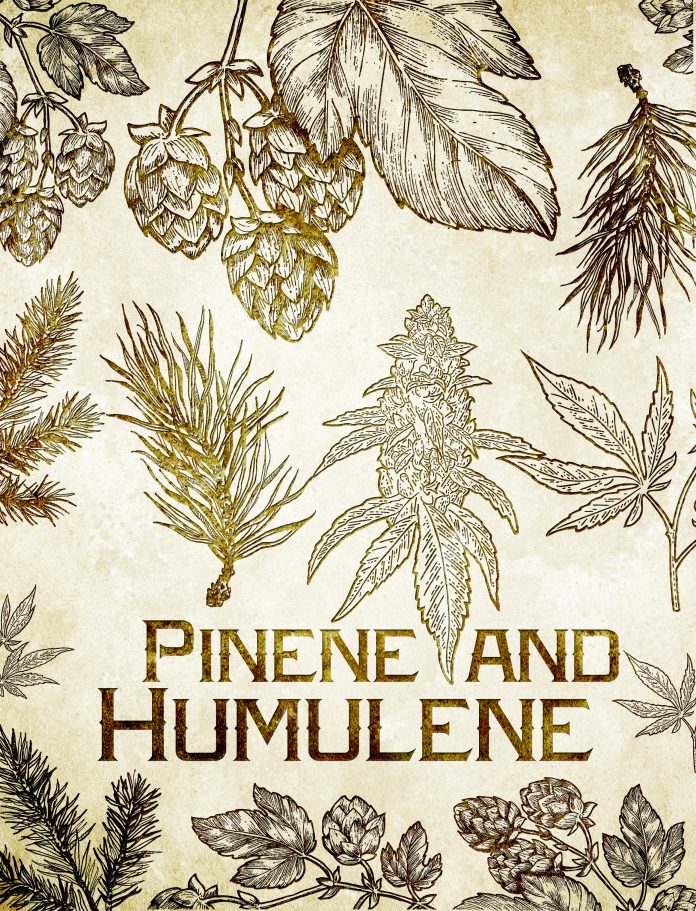By Jake Towner
Within this article are details discussing pinene and humulene, terpenes found in some cannabis strains. Each of them has an earthy flavor you may already know. I chose to discuss pinene and humulene together because they are complimentary flavors and, in my opinion go together well.
First, lets talk about pinene, which is a lot more common than you think. Pinene has two structural isomers, the alpha and beta forms, denoted α-pinene and β-pinene. Alpha pinene smells like pine needles or rosemary, and the latter type smells more of dill, parsley, or basil. Pinene forms the basis of the industrial solvent turpentine which has various uses within the industry, and many biochemical effects upon consumption. It is enzymatically produced in plants by the precursor geranyl pyrophosphate and is a bicyclic monoterpene. This may not surprise you, but pine trees emit large amounts of pinene into the atmosphere. The reason conifer forests smell the way they do is largely because pinene is a highly aromatic compound and exists in the forests’ air!
Indeed, these monoterpenes form the largest component of plant emissions in the atmosphere, as pinene reacts with ozone to form compounds that play environmental roles. Pine trees are just one of the many coniferous trees that emit pinene into the atmosphere, among many other plants, like cannabis.
Maybe you’ve heard of chewing mint gum before studying, and before taking a test, to improve test scores? Pinene and essential oils with pinene, may provide similar effects. Pinenes diverse biological effects range from bronchodilation, to acetylcholinesterase inhibition. Pinenes’ acetylcholinesterase inhibition means that it has effects on memory, and memory formation. This suggests pinene can act as a nootropic and may benefit the mind by increasing the availability of crucial acetylcholine. It is microbial, anti-inflammatory and can even act at the benzodiazepine binding site. Pinene’s anti-inflammatory effects are due to an effect on prostaglandin E1, or PGE1, which opens blood vessels by relaxing the smooth muscle, and plays a role in the inflammation response.
Next on the list is humulene – and I really want to tie in a little additional information about humulene for any beer drinkers out there – hops are one of the main ingredients in beer, and hops are also one of the natural sources of humulene! If you are a beer drinker or crafter, choose the noble hops that contain larger amounts of humulene, not the bitter varieties. It is produced enzymatically from farnesyl diphosphate. Hops contain pinene and is part of the reason why I write about them together in this article. Humulene is also called α-humulene, or α-caryophyllene, and it is a monocyclic sesquiterpene. A fun fact about humulene is that it has three double bonds, which has a huge effect on its reactivity and the products it forms. There is not a satisfying amount of data supporting medical benefits of humulene other than anti-inflammatory effects, and even that data is still in the research and development phase. There is a suggestion that some health benefits for beer drinkers could be available for cannabis consumers because humulene is a shared constituent.
The importance of humulene having three double bonds is that humulene like pinene reacts with ozone in the atmosphere. Its’ products are oxygenated forms of humulene that can have further atmospheric and biological consequences when you consider products have their own properties. Growing cannabis, which one supports when consuming cannabis, fills the air with these aromatic compounds. It isn’t too far-fetched to say than the ozone layer is maintained in balance by terpenes in the atmosphere to a certain extent. I want to take this portion of the article to express the sentiment that the cannabis industry is one of the greenest movements one can support largely because of an unpublicized biproduct of cannabis production. Deforestation and urbanization impact our environment in a negative way, but cannabis support could reverse some of the damage done to our air quality, and to help our bodily ailments too.


















